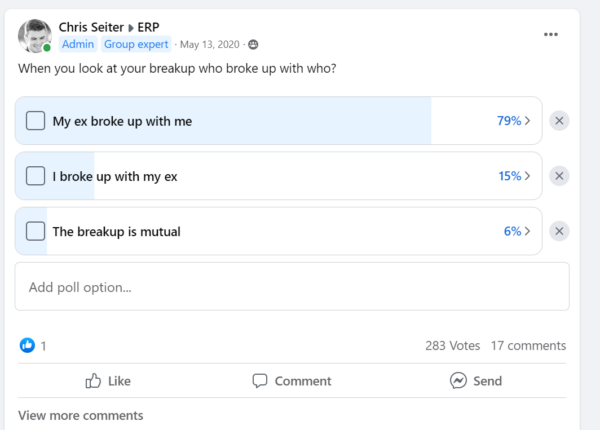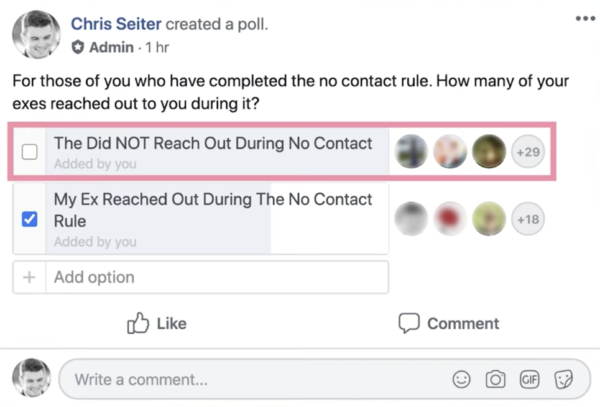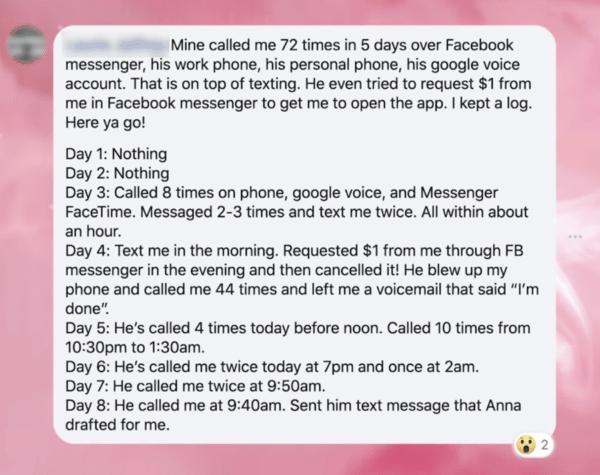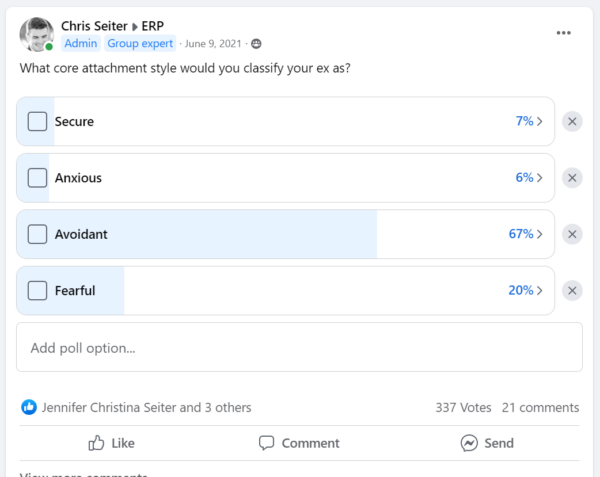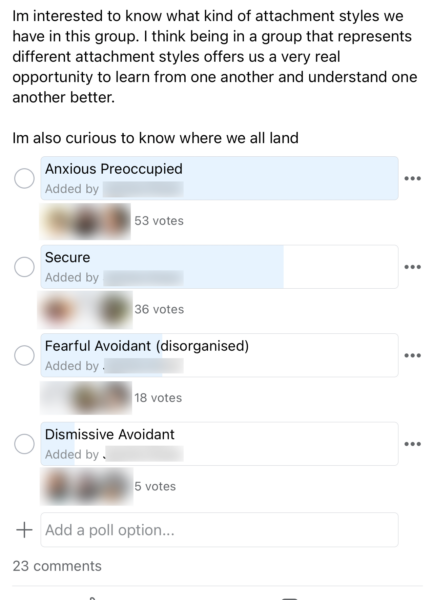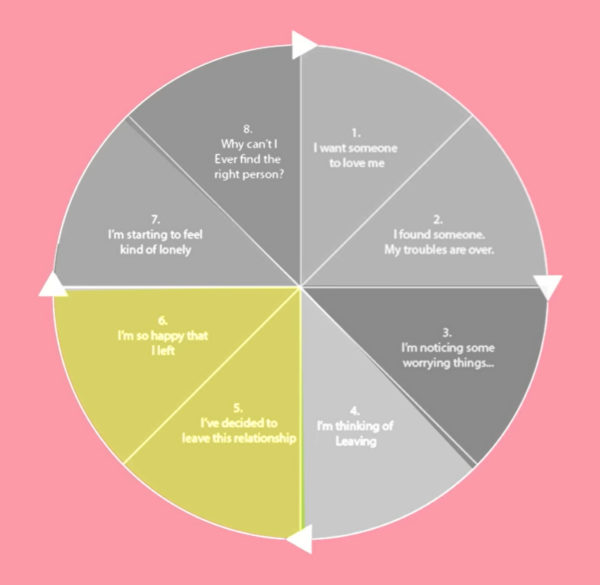Everyone reveres silence as this amazing thing to use on your ex after a breakup. They’ll say that “it’ll help your ex notice your absence,” or “it’ll make them miss you more.”
And they might be right.
But I go curious what actually happens to an ex when you use silence on them. So, I spent a week researching exactly that and determined that silence on an ex will do the six following things to them,
- Trigger A Loss And Grief Processing Scenario
- Potentially Trigger Psychological Reactance Which Can Lead To…
- Cognitive Dissonance
- Contrary To What Everyone Thinks, They Aren’t As Likely To Reach Out To You
- They’ll Go Through This Period Of Separation Elation
- If You Move On They’ll Have Nostalgic Reverie
This is going to be a fun one. Let’s dive in!

What Are Your Chances of Getting Your Ex Boyfriend Back?
Take the quizEffect #1: Trigger A Loss And Grief Processing Scenario
Truly, the study of silence on an ex is essentially the study of the no contact rule on an ex.
Fortunately, there has been significant research on what the no contact rule does to an ex. Personally, I believe I’m at the forefront of this research, having dedicated 10 years to studying this topic daily.
What I’ve observed is that there’s a loss and grief processing element that occurs when you apply the no contact rule to an ex. It’s somewhat akin to experiencing a death.
With death, you encounter stages of grief: denial, anger, bargaining, depression, and acceptance. Silence brings its own set of grief stages.
A few years ago, I recorded a podcast that navigated the varied stages exes often experience when subjected to the no contact rule.
(And then for good measure I filmed a video 😉 ).
A recurring theme throughout this video is that most of the clients we studied were the ones who had been broken up with.
You can see that in this poll here,
An intriguing dynamic unfolds when the client’s ex, who initiated the breakup, finds themselves on the receiving end of the no contact rule.
- Initially, during the onset of the no contact rule, the ex appears confident in their decision.
- However, as a week or two elapses without any communication, anxiety sets in.
- When they discern that they’re being deliberately ignored, their feelings often turn to anger.
- They then grapple with the possibility of having lost you forever…
- Leading them to hope you’ll reach out.
It’s crucial to underline that the emotion here is hope for contact, rather than an assured expectation of it.
A prevalent misconception regarding the no contact rule is the expectation that the ex will initiate contact. In reality, our data indicates that the majority of exes don’t reach out at all.
I’ll delve into this more later on, but I believe it’s also imperative to touch upon another psychological facet of silence.
Effect #2: Psychological Reactance
Take a look at this screenshot:
This is a screenshot of one of our client’s exes blowing up their phone after a no contact period was implemented.

What Are Your Chances of Getting Your Ex Boyfriend Back?
Take the quizThis is a textbook case of psychological reactance in action.
So, what exactly is psychological reactance?
It’s essentially a psychological concept that posits that human beings possess certain behavioral freedoms, such as the freedom to communicate with you. When that freedom is taken away, they’re inclined to act in ways to reclaim that lost freedom.
This explains why we sometimes observe reactions like the one in the screenshot I just mentioned.
However, what strikes me as particularly fascinating is that the entire breakup industry seems to lean heavily on psychological reactance. They champion the no contact rule, assuming it will make your ex miss you.
While it’s possible, it’s not typically the norm.
I proved that with this research,
It may sound strange, but instances like the one in the aforementioned screenshot are often exceptions rather than the standard. More commonly, what emerges is a more intricate psychological phenomenon: cognitive dissonance.
Effect #3: Cognitive Dissonance
Cognitive dissonance is fundamentally a mental discomfort arising from two conflicting beliefs, values, or attitudes.
For example, someone might still harbor feelings for their ex, yet simultaneously recognize the necessity of separation. Such tension gives rise to considerable internal conflict, often prompting rationalizations or shifts in attitude to alleviate this discomfort.
In the realm of silence, particularly for many of our clients who find themselves on the receiving end of breakups, an interesting dynamic emerges.
There’s a prevailing assumption among exes that the one left behind will inevitably plead for a reunion. Our research into attachment styles between our clients and their former partners corroborates that a majority of these exes indeed harbor this expectation—
Avoidant Exes:
Anxious Client:
Typically in breakup scenarios like this, the avoidant individual’s behavior is influenced by past experiences where the partner left behind had indeed pleaded for another chance.
Such behaviors solidify a certain perception about the spurned individual: they are desperate for reconciliation.
However, when the no-contact rule is put into play, cognitive dissonance can rear its head.
An ex might be convinced that their former partner still yearns for them, but over time, when silence persists, they start to question this conviction. This tug-of-war of beliefs creates inner turmoil and may spark new rationalizations or a change in their attitudes.
Revisiting the psychological reactance example, consider the individual who inundated our client’s phone with messages.
Initially, they were convinced of their ex’s longing. Yet, confronted by the extended silence and seeming detachment, they dramatically shift their stance—potentially an overreaction fueled by their own cognitive dissonance.

What Are Your Chances of Getting Your Ex Boyfriend Back?
Take the quizThis transformation exemplifies why I position psychological reactance alongside cognitive dissonance: there’s a symbiotic relationship between the two. Psychological reactance can indeed catalyze intense cognitive dissonance effects.
Effect #4: The Majority Of Exes Actually Won’t Reach Out
However, it’s essential to note that a vast majority of exes won’t initiate contact during the no-contact phase.
Consider this poll from a few years back, where I inquired, “For those who’ve applied the no-contact rule, how many of your exes actually got in touch during that period?”
A striking 62-64% of exes refrained from reaching out to our clients. This inaction, however, doesn’t denote indifference. Rather, I interpret it to signify that most of the exes under our study likely possess avoidant attachment styles.
Due to their inherent disposition, they opt for silence.
Effect #5: Separation Elation
At first, someone with an avoidant attachment style will experience a period of separation elation.
To comprehend why, it’s essential to grasp the core wound of an avoidant.
There are three distinct insecure attachment styles:
- Anxious
- Dismissive
- Fearful
For those with an anxious attachment style, triggers revolve around fears of abandonment.
For those with a dismissive attachment style, triggers arise from perceived threats to their independence, such as discussions about marriage, cohabitation, starting a new relationship, or having children.
Meanwhile, individuals with a fearful attachment style carry both core wounds, making them susceptible to both sets of triggers. They’re also the rarest of the trio.
In our observations, many of our clients’ exes seem to exhibit a dismissive avoidant attachment style.
Once again here’s the proof,
Initially, these individuals revel in the silence.
I delve deeper into this in my ‘avoidant death wheel’ segment, particularly around stages five and six.
They genuinely relish the departure, often in the midst of the no-contact phase.
They genuinely feel relieved when their partner departs, and this sentiment is genuine. However, it’s fleeting. It’s crucial to note that this ‘separation elation’ is akin to a mini honeymoon phase.
Just as relationships commence with a honeymoon period, they also conclude with one, especially for avoidants who feel they’ve regained their most cherished possession: freedom and independence.

What Are Your Chances of Getting Your Ex Boyfriend Back?
Take the quizYet, the complexity of avoidants lies in their inherent contradiction: their natural tendencies push them towards solitude, but deep down, they don’t desire eternal solitude.
This internal conflict can lead them to experience bouts of depression over time.
Here’s a relevant quote I found from a great avoidant attachment resource:
But they can have a depressive episode from 2-4 months after a breakup, manifested in feeling numb, disconnected and meaningless, which they may try to repress. Everybody needs deeper connection, but often avoidants don’t recognise they need their partners until the partner actually loses interest and leaves, through separation, divorce, also death, illness, or something else.
Effect #6: Nostalgic Reverie
What we’ve discovered is that when we advise our clients to use this silent period – the no-contact phase – to give the impression they are moving on from their ex, it weakens the avoidant’s defenses.
This prompts the exes to either view our clients as phantom exes or embark on a curious journey down memory lane where they selectively recall only the good times, leading them into a nostalgic reverie.
All these reactions are primarily evoked through silence.
However, I’d argue that it’s not merely the act of remaining silent that yields such remarkable results.
It’s the actions you undertake during that silence that matter.
For illustration, consider two individuals.
- One person, post-breakup, opts for a no-contact rule but remains inactive towards pursuing personal ambitions or setting new goals. Their approach is simple: ignore their ex for 30 to 45 days. This person avoids social media, doesn’t engage in making new friendships or trying novel experiences.
- Conversely, another individual, while adhering to the 30 to 45 days of no contact, capitalizes on this period. They venture out, embark on new experiences, elevate their lifestyle, and engage in activities they’ve always yearned for. Subtly, they share these exploits on social media.
Between the two, the latter always reaps more benefits. Their proactive approach gives the impression of moving on, which in turn reduces their ex’s defenses and invokes nostalgic feelings. This increases the chances of the ex being receptive to a conversation should there be a desire for reconciliation.
Marcus Aurelius, a renowned Stoic philosopher, once advised,
‘Live each day as if it will be your last.’
This is a reflection on the value of time. Consider how you spend or squander your time; imagine how differently you’d act if you knew your days were numbered. Chances are, you wouldn’t let a moment go to waste.
